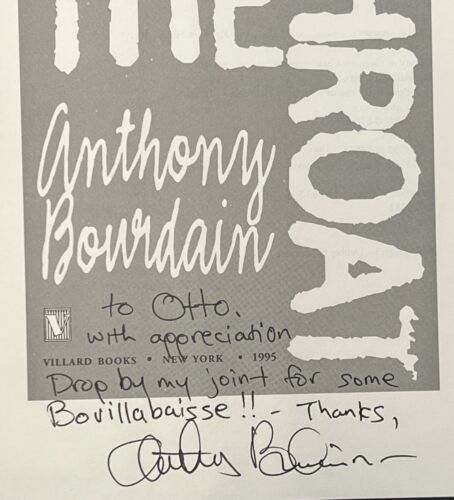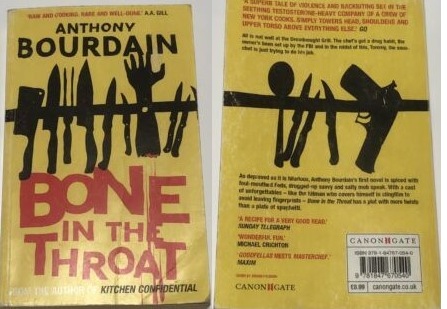We may earn an affiliate commission from any company linked to in this post.
Anthony Bourdain may have been a contemporary kitchen pirate, the world traveling “GOAT”, and an underrated author, but his first novel, Bone in the Throat, is where he did something strange: he stuck to crime fiction. It’s a blood-slicked, greasy slice of noir served with heroin relapse duck confit, and the result is as messy (and occasionally brilliant) as you’d expect.
Published in ’95, half a decade before Kitchen Confidential put him on David Letterman and beyond, Bone in the Throat is a novel only Bourdain could’ve concocted. Not because it’s a masterpiece in the genre (it isn’t) but because it’s without a doubt him: vulgar, raw, culinary, and chaotic.
The novel’s setup reads like a fever dream
Tommy Pagano, a young sous-chef at the struggling Dreadnaught Grill in Manhattan’s Little Italy, finds himself caught between the FBI and his uncle Sally, a loan shark and hitman with a tendency to treat meat cleavers as multipurpose tools. When Sally uses the restaurant to stage a murder, Tommy becomes an unwilling accomplice- and a target.
But this isn’t your usual mob thriller. Sure, there’s murder, dismemberment, wiretaps, and federal stings, but it’s all seasoned with Bourdain’s love of kitchens and contempt for pretension. The most vivid scenes aren’t the shootouts or interrogations, they’re in the cramped, sweltering back-of-house spaces where cooks chop, sweat, curse, and grind out dinner service while the world falls apart around them.
*Bone in the Throat is out of print, but you can still find it on Amazon offered by some sellers.
Culinary Crime made Literary
 This isn’t a fast-paced caper or a polished crime drama. It’s closer to a “kitchen noir,” with long detours into the personal lives of cooks, junkies, and low-level mobsters who are just trying to stay out of jail (or alive). There’s a grungy realism to it, and some of the most powerful moments come not from plot twists but from the way Bourdain captures the rhythm of kitchen life and addiction. You can practically smell the consommé and the cocaine.
This isn’t a fast-paced caper or a polished crime drama. It’s closer to a “kitchen noir,” with long detours into the personal lives of cooks, junkies, and low-level mobsters who are just trying to stay out of jail (or alive). There’s a grungy realism to it, and some of the most powerful moments come not from plot twists but from the way Bourdain captures the rhythm of kitchen life and addiction. You can practically smell the consommé and the cocaine.
Tommy, the protagonist, feels like a younger Bourdain split in two. There’s the ambitious culinary upstart trying to do things right, and then there’s Michael, the head chef battling heroin addiction—an echo of Bourdain’s own struggles. These characters are where the novel sings. The mobsters, on the other hand, are less convincing; cartoonish at times, with dialogue that often reads like a bad Scorsese parody. “Maybe he’s runnin’ out for a head of lettuce,” says one character. Seriously.
Missed Opportunities & Flat Finishes

Despite its culinary flair and occasional bursts of genius, Bone in the Throat stumbles on some classic first-novel pitfalls. The pacing is uneven, the plot drifts, and secondary storylines (like the chef’s methadone program) muddy the momentum. The ending, meant to be a dramatic unraveling, lands with more of a shrug than a bang.
Worse, the book’s female characters are virtually nonexistent, a blind spot that feels glaring even by 1990s crime standards. And while the cover and title are clever (and very Bourdain), the actual narrative never quite delivers on that promise of culinary crime fusion.
From Book to Screen—and Back Again?
Interestingly, the novel was adapted into a low-budget film in 2015. Like the book, the movie flew under the radar. It may be worth checking out for completists or Bourdain superfans, but don’t expect Goodfellas. Think more Kitchen Confidential meets Law & Order, if every character was half-buzzed and holding a chef’s knife.
Final Thoughts
Bone in the Throat is no literary masterpiece. But it’s also not a waste of time, especially for fans of Bourdain’s other work. It’s a rough sketch of the man he would later become in his nonfiction: honest, chaotic, cynical, and deeply in love with food and the people who make it. The novel has its flaws, but it also has heart, guts, and gravy.
For those curious about Bourdain’s early voice (or just craving a different kind of crime story, one set not in dark alleys but in hot kitchens), it’s worth a taste. Just don’t expect a five-course meal. This one’s more like a late-night plate of leftovers: greasy, flawed, and oddly satisfying.
Would you read Bourdain’s second novel, Gone Bamboo, or stick to his nonfiction? Let me know in the comments.

Facebook Comments